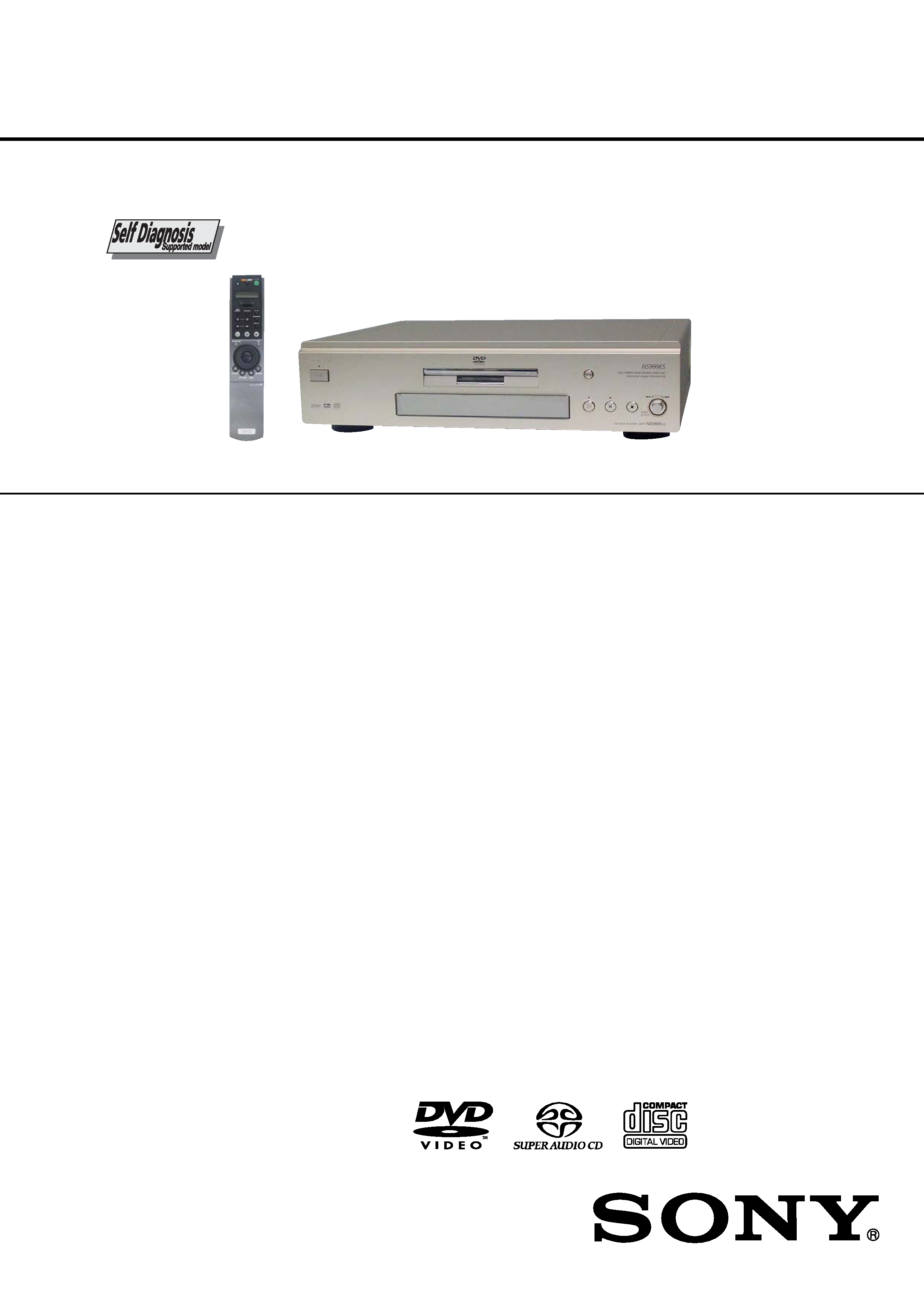
SERVICE MANUAL
US Model
Canadian Model
AEP Model
UK Model
Korean model
CD/DVD PLAYER
DVP-NS999ES
RMT-D150A/D150P
SPECIFICATIONS
Photo: Gold type
System
Laser: Semiconductor laser
Signal format system:
NT
PAL/(NTSC): AEP, UK, KR
SC: US, CND
Audio characteristics
Frequency response: DVD VIDEO (PCM
96 kHz): 2 Hz to 44 kHz (44 kHz: 2 dB
±1 dB), Super Audio CD: 2 Hz to
100 kHz (50 kHz: 3 dB
±1dB), CD:
2Hz to 20 kHz (
±0.5 dB)
Harmonic distortion: DVD VIDEO/Super
Audio CD: 0.0012 %, CD: 0.0016 %
Dynamic range: DVD VIDEO/Super Audio
CD: 103 dB, CD: 99 dB
Wow and flutter: Less than detected value
(
±0.001% W PEAK)
Outputs
(Jack name: Jack type/Output level/Load
impedance)
AUDIO OUT 1/2: Phono jack/2 Vrms/
10 kilohms
DIGITAL OUT (OPTICAL): Optical
output jack/18 dBm (wave length:
660 nm)
DIGITAL OUT (COAXIAL): Phono jack/
0.5 Vp-p/75 ohms
5.1CH OUTPUT: Phono jack/2 Vrms/
10 kilohms
COMPONENT VIDEO OUT(Y, PB, PR):
Phono jack/Y: 1.0 Vp-p/PB, PR:
interlace*=0.648 Vp-p, progressive or
interlace**=0.7 Vp-p/75 ohms
*BLACK LEVEL is ON
** BLACK LEVEL is OFF
VIDEO OUT 1/2: Phono jack/1.0 Vp-p/
75 ohms
S VIDEO OUT 1/2: 4-pin mini DIN/Y:
1.0 Vp-p, C: 0.286 Vp-p/75 ohms
General
Power requirements:
120V AC, 60 Hz (US, CND)
220 V 240 V AC, 50/60 Hz
(AEP, UK, KR)
Power consumption:
23 W (AEP, UK, KR)
20 W (US, CND)
Dimensions (approx.):
430
× 113 × 349 mm (17 × 4 1/2 × 13 3/4
in.) (width/height/depth) incl. projecting
parts
Mass (approx.):6.4 kg (14 lb 2 oz)
Operating temperature: 5
°C to 35 °C
(41
°F to 95 °F)
Operating humidity: 25 % to 80 %
Supplied accessories
Specifications and design are subject to
change without notice.
Check that you have the following items:
·Audio/video cord (pinplug
× 3 y pinplug
× 3) (1)
·Power cord (1)
·Remote commander (remote) (1)
·Siz
· Abbreviation
CND : Canadian
KR : Korea
e AA (R6) batteries (2)

2
WARNING!!
WHEN SERVICING, DO NOT APPROACH THE LASER
EXIT WITH THE EYE TOO CLOSELY. IN CASE IT IS
NECESSARY TO CONFIRM LASER BEAM EMISSION,
BE SURE TO OBSERVE FROM A DISTANCE OF
MORE THAN 25 cm FROM THE SURFACE OF THE
OBJECTIVE LENS ON THE OPTICAL PICK-UP BLOCK.
CAUTION
Use of controls or adjustments or performance of procedures
other than those specified herein may result in hazardous ra-
diation exposure.
ATTENTION AU COMPOSANT AYANT RAPPORT
À LA SÉCURITÉ!
LES COMPOSANTS IDENTIFIÉS PAR UNE MARQUE 0
SUR LES DIAGRAMMES SCHÉMATIQUES ET LA LISTE
DES PIÈCES SONT CRITIQUES POUR LA SÉCURITÉ
DE FONCTIONNEMENT. NE REMPLACER CES COM-
POSANTS QUE PAR DES PIÈCES SONY DONT LES
NUMÉROS SONT DONNÉS DANS CE MANUEL OU
DANS LES SUPPLÉMENTS PUBLIÉS PAR SONY.
SAFETY-RELATED COMPONENT WARNING!!
COMPONENTS IDENTIFIED BY MARK 0 OR DOTTED
LINE WITH MARK 0 ON THE SCHEMATIC DIAGRAMS
AND IN THE PARTS LIST ARE CRITICAL TO SAFE
OPERATION. REPLACE THESE COMPONENTS WITH
SONY PARTS WHOSE PART NUMBERS APPEAR AS
SHOWN IN THIS MANUAL OR IN SUPPLEMENTS PUB-
LISHED BY SONY.
Fig. A.
Using an AC voltmeter to check AC leakage.
1.5 k
0.15 µF
AC
voltmeter
(0.75 V)
To Exposed Metal
Parts on Set
Earth Ground
LEAKAGE TEST
The AC leakage from any exposed metal part to earth ground
and from all exposed metal parts to any exposed metal part having
a return to chassis, must not exceed 0.5 mA (500 microamperes).
Leakage current can be measured by any one of three methods.
1. A commercial leakage tester, such as the Simpson 229 or RCA
WT-540A. Follow the manufacturers' instructions to use these
instruments.
2. A battery-operated AC milliammeter. The Data Precision 245
digital multimeter is suitable for this job.
3. Measuring the voltage drop across a resistor by means of a
VOM or battery-operated AC voltmeter. The "limit" indica-
tion is 0.75V, so analog meters must have an accurate low-
voltage scale. The Simpson 250 and Sanwa SH-63Trd are ex-
amples of a passive VOM that is suitable. Nearly all battery
operated digital multimeters that have a 2V AC range are suit-
able. (See Fig. A)
1. Check the area of your repair for unsoldered or poorly-sol-
dered connections. Check the entire board surface for solder
splashes and bridges.
2. Check the interboard wiring to ensure that no wires are
"pinched" or contact high-wattage resistors.
3. Look for unauthorized replacement parts, particularly transis-
tors, that were installed during a previous repair. Point them
out to the customer and recommend their replacement.
4. Look for parts which, though functioning, show obvious signs
of deterioration. Point them out to the customer and recom-
mend their replacement.
5. Check the line cord for cracks and abrasion. Recommend the
replacement of any such line cord to the customer.
6. Check the B+ voltage to see it is at the values specified.
7. Check the antenna terminals, metal trim, "metallized" knobs,
screws, and all other exposed metal parts for AC leakage.
Check leakage as described below.
SAFETY CHECK-OUT
After correcting the original service problem, perform the following
safety checks before releasing the set to the customer:
CAUTION:
The use of optical instrument with this product will increase eye
hazard.
This appliance is classified as a
CLASS 1 LASER product. The
CLASS 1 LASER PRODUCT
MARKING is located on the rear
exterior.
This label is located on the side of
the player.

3
Unleaded solder
Boards requiring use of unleaded solder are printed with the lead-
free mark (LF) indicating the solder contains no lead.
(Caution: Some printed circuit boards may not come printed with
the lead free mark due to their particular size.)
: LEAD FREE MARK
Unleaded solder has the following characteristics.
· Unleaded solder melts at a temperature about 40
°C higher than
ordinary solder.
Ordinary soldering irons can be used but the iron tip has to be
applied to the solder joint for a slightly longer time.
Soldering irons using a temperature regulator should be set to
about 350
°C.
Caution: The printed pattern (copper foil) may peel away if the
heated tip is applied for too long, so be careful!
· Strong viscosity
Unleaded solder is more viscous (sticky, less prone to flow) than
ordinary solder so use caution not to let solder bridges occur
such as on IC pins, etc.
· Usable with ordinary solder
It is best to use only unleaded solder but unleaded solder may
also be added to ordinary solder.

4
TABLE OF CONTENTS
Section
Title
Page
Section
Title
Page
Service Note ............................................................................ 5
1.
GENERAL
Precautions ................................................................... 1-1
Simple Start Guide ........................................................ 1-4
Hookups ........................................................................ 1-5
Playing Discs ................................................................. 1-8
Searching for a Scene ................................................... 1-12
Viewing Information About the Disc .............................. 1-13
Sound Adjustments ....................................................... 1-14
Enjoying Movies ............................................................ 1-14
Using Various Additional Functions .............................. 1-16
Settings and Adjustments ............................................. 1-18
Additional Information ................................................... 1-21
2.
DISASSEMBLY
2-1.
Top Case Removal ........................................................ 2-1
2-2.
Front Panel Block Assembly Removal .......................... 2-1
2-3.
FL-129 Board Removal ................................................. 2-1
2-4.
Power Block Removal ................................................... 2-1
2-5.
IF-98 Board Removal .................................................... 2-2
2-6.
Power Transformer Removal ......................................... 2-2
2-7.
Mechanism Deck Removal ........................................... 2-2
2-8.
AU-232 Board Removal ................................................ 2-2
2-9.
EV-15 Board Removal (AEP, UK) .................................. 2-3
2-10. VP-58 Board Removal (US, CND, KR) ......................... 2-3
2-11. MB-107 Board Removal ................................................ 2-3
2-12. CK-119 Board Removal ................................................ 2-3
2-13. Loading Assembly Removal .......................................... 2-4
2-14. Optical Pick-up Removal ............................................... 2-4
2-15. Internal View .................................................................. 2-5
2-16. Circuit Boards Location ................................................. 2-6
3.
BLOCK DIAGRAMS
3-1.
Overall Block Diagram ................................................... 3-1
3-2.
RF/Servo Block Diagram ............................................... 3-3
3-3.
Signal Processor Block Diagram .................................. 3-5
3-4.
System Control Block Diagram ..................................... 3-7
3-5.
Video (1) Block Diagram ............................................... 3-9
3-6.
Video (2) Block Diagram ............................................... 3-11
3-7.
Video Block Diagram .................................................... 3-13
3-8.
Audio (1) Block Diagram ............................................... 3-15
3-9.
Audio (2) Block Diagram ............................................... 3-17
3-10. Interface Control Block Diagram ................................... 3-19
3-11. Power (1) Block Diagram .............................................. 3-21
3-12. Power (2) Block Diagram .............................................. 3-23
3-13. Power (3) Block Diagram .............................................. 3-25
4.
PRINTED WIRING BOARDS AND SCHEMATIC
DIAGRAMS
4-1.
Frame Schematic Diagram ............................................ 4-3
4-2.
Printed Wiring Boards and Schematic Diagrams ......... 4-5
MB-107 Printed Wiring Board ....................................... 4-5
MB-107 (RF AMP, SERVO) Schematic Diagram .......... 4-9
MB-107 (ARP, SERVO DSP) Schematic Diagram ........ 4-11
MB-107 (AV DECODER) Schematic Diagram .............. 4-13
MB-107 (MOTOR DRIVE) Schematic Diagram ............ 4-15
MB-107 (SYSTEM CONTROL)
Schematic Diagram ....................................................... 4-17
MB-107 (CLOCK GENERATOR)
Schematic Diagram ....................................................... 4-19
MB-107 (I/P CONVERTOR) Schematic Diagram ......... 4-21
MB-107 (VIDEO ENCODER) Schematic Diagram ....... 4-23
MB-107 (AUDIO DSP) Schematic Diagram .................. 4-25
MB-107 (2ch/6ch DAC I/O) ........................................... 4-27
MB-107 (NAND FLASH I/F, EXTENSION I/O)
Schematic Diagram ....................................................... 4-29
MB-107 (AUDIO DELAY) Schematic Diagram .............. 4-31
MB-107 (SACD DECODER) Schematic Diagram ........ 4-33
MS-113 (LOADING MOTOR), CK-119 (SENSOR)
Printed Wiring Board and Schematic Diagram ............. 4-35
VP-58 Printed Wiring Board .......................................... 4-37
VP-58 (VIDEO BUFFER) Schematic Diagram ............. 4-41
VP-58 (VIDEO AMP) Schematic Diagram .................... 4-43
AU-232 Printed Wiring Board ........................................ 4-45
AU-232 (AUDIO OUT) Schematic Diagram .................. 4-47
FL-129 Printed Wiring Board ........................................ 4-49
FL-129 (IF CON) Schematic Diagram .......................... 4-51
FR-190, SW-381 Printed Wiring Board ......................... 4-53
FR-190 (FUNCTION SWITCH), SW-381
(PUSH ENTER SWITCH) Schematic Diagram ............ 4-55
EV-15 Printed Wiring Board .......................................... 4-57
EV-15 (EURO AV1) Schematic Diagram ...................... 4-61
EV-15 (EURO AV2) Schematic Diagram ...................... 4-63
EV-15 (EURO AV3) Schematic Diagram ...................... 4-65
IF-98, LD-115 Printed Wiring Board ............................. 4-67
IF-98 (INTER FACE),
LDI-115 (LED) Schematic Diagram .............................. 4-68
ZSSR107G Printed Wiring Board ................................. 4-69
ZSSR107G (SWITCHING REGULATOR)
Schematic Diagram ....................................................... 4-71
ZSSR107H Printed Wiring Board ................................. 4-73
ZSSR107H (SWITCHING REGULATOR)
Schematic Diagram ....................................................... 4-75
5.
IC PIN FUNCTION DESCRIPTION
5-1.
System Control Pin Function
(MB-107 Board IC104) .................................................. 5-1
6.
TEST MODE
6-1.
General Description ...................................................... 6-1
6-2.
Starting Test Mode ........................................................ 6-1
6-3.
Syscon Diagnosis .......................................................... 6-1
6-4.
Drive Auto Adjustment .................................................. 6-6
6-5.
Drive Manual Operation ................................................ 6-8
6-6.
Mecha Aging ................................................................. 6-11
6-7.
Emergency History ........................................................ 6-11
6-8.
Version Information ....................................................... 6-12
6-9.
Video Level Adjustment ................................................ 6-12
6-10. IF CON Self Diagnostic Function .................................. 6-12
6-11. Troubleshooting ............................................................. 6-20
7.
ELECTRICAL ADJUSTMENT
7-1.
Power Supply Check ..................................................... 7-1
1.
ZSSR107G Board: US, CND
ZSSR107H Board: AEP, UK, KR ................................... 7-1
7-2.
Adjustment of Video System ......................................... 7-2
1.
Composite Video Level Adjustment .............................. 7-2
2.
Component Video Level Adjustment ............................. 7-2
3.
Checking S Video Output S-Y ....................................... 7-2
4.
Checking S Video Output S-C ....................................... 7-2
5.
Checking Component Video Output Y .......................... 7-3
6.
Checking Component Video Output B-Y ...................... 7-3
7.
Checking Component Video Output R-Y ...................... 7-3
8.
Checking RGB Output R (AEP, UK model) ................... 7-3
9.
Checking RGB Output G (AEP, UK model) .................. 7-4
10. Checking RGB Output B (AEP, UK model) ................... 7-4
7-3.
Adjustment Related Parts Arrangement ....................... 7-6
8.
REPAIR PARTS LIST
8-1.
Exploded Views ............................................................. 8-1
8-1-1. Front Panel Assembly .............................................. 8-1
8-1-2. Chassis Assembly-1 ................................................. 8-2
8-1-3. Chassis Assembly-2 ................................................. 8-3
8-1-4. Mechanism Deck Assembly ..................................... 8-4
8-2.
Electrical Parts List ....................................................... 8-5

5
SERVICE NOTE
1.
DISASSEMBLY
·This set can be disassembled in the order shown below.
Set
Top Case
(Page 2-1)
Front Panel
Block Assembly
(Page 2-1)
FL-29 Board
(Page 2-1)
CK-119 Board
(Page 2-3)
Optical Pick-up
(Page 2-4)
Power Block
(Page 2-1)
Mechanism
Deck
(Page 2-2)
IF-98 Board
(Page 2-2)
Loading
Assembly
(Page 2-4)
EV-15 Board
(Page 2-3)
VP-58 Board
(Page 2-3)
Power
Transformer
(Page 2-2)
AU-232 Board
(Page 2-2)
MB-107 Board
(Page 2-3)
